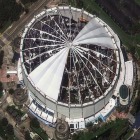
Major League Baseball has, over the years, treated the Arizona Fall League like a sandbox environment, experimenting with different rules and approaches to the game. That trend is continuing this year, with Tuesday's contest between the Salt River Rafters and the Scottsdale Scorpions featuring the first-ever automated check swing challenge.
The first challenge of its kind came during the second inning, when Mets outfielder Drew Gilbert attempted to hold up on a 3-1 pitch from Diamondbacks righty Dylan Ray. After the third-base umpire deemed that Gilbert had offered, running the count full, Gilbert triggered the challenge by tapping on his helmet. Upon review, the call on the field was overturned and Gilbert was granted his base on balls.
Here's some video of the scene:
News from the AFL: Now you can challenge checked swings. pic.twitter.com/cRtEUU9o8l
— Josh Norris 🐻 (@jnorris427) October 23, 2024
And here's how Baseball America's Josh Norris explained the ruling system:
The video board animation goes like this: First, it shows the movement of the bat from the side. Next, the image shifts to an overhead view with the bat frozen in its final position. Then, a dotted line is drawn through the barrel and knob of the bat. If the bat's barrel is judged to have traveled more than 45 degrees past its final stopping point, then it is judged a swing. If it moves less than 45 degrees, then it's not a swing. It is not clear which way the call would go if the barrel lands at exactly 45 degrees.
There's no indication of if and/or when the automated check-swing challenge will make its way to the regular season and up to the majors. (MLB continues to experiment with the automated ball-strike system in the minor leagues, with commissioner Rob Manfred suggesting it could be introduced down the road in MLB using a similar challenge system.)
What makes this whole experiment particularly interesting is that it's the first time that MLB will have to define what, precisely, constitutes a swing. As our Matt Snyder detailed back in 2019, there's no guideline presented in MLB's rulebook on the matter. It appears that bat-tracking technology just might change that in the near future.

















